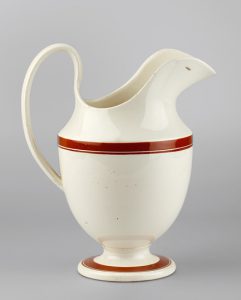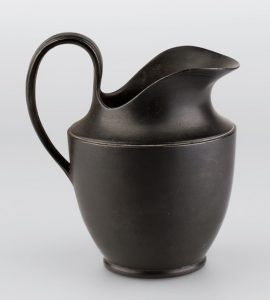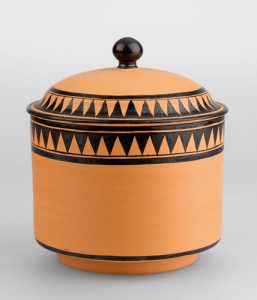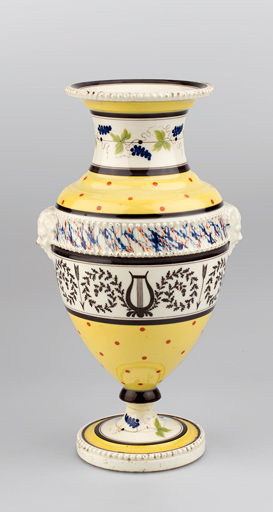



Refined (white) earthenware in CERAMICA CH
Andreas Heege, 2023
Refined white earthenware evolved shortly before the middle of the 18th century from the salt-glazed white stoneware of Staffordshire and Yorkshire (England). From the mid to late 18th century, it was also produced in France, Germany and Switzerland. As a rule, the fabric is cream coloured to yellowish or off-white, very fine-grained, non-vitreous, specifically light-weight and with a clearly visible separate layer of glaze. The latter often exhibits craquelé, or crazing, particularly in archaeological finds. From a technical perspective, it is lead-glazed, porous earthenware made from clay that becomes white when fired and contains kaolin and SiO2 (quartz, often powdered flint); it can also contain lime or feldspar or a mixture of all components. Depending on when and where the pottery was produced, the composition of the clay body can vary considerably. The fabric used to produce refined white earthenware can be mould-pressed and cast, and in contrast to the clays used to produce the usual wheel-thrown pottery, is suitable for industrial mass production.
Refined white earthenware objects are generally biscuit-fired first. The painted, printed, stencilled or sponged decoration is applied to the biscuit and the piece is then lead-glazed. The second firing at a temperature of around 1000 ºC is known as “glost firing”. A possible third step involves applying onglaze colours or lustre, which are fixed in a third firing at around 800 ºC called “muffle firing“.
Due to the colour and matrix of its fabric, refined white earthenware is also known as “weisse Irdenware” – “white-bodied industrial earthenware” – “terres blanches”. Because of its manufactur in dedicated industrial plants, refined white earthenware in all its forms is also known as “industrial pottery” (Bartels 1999, 250-259; Stellingwerf 2019, 42-51). By adding cobalt to the cream-coloured or yellowish clay body of “creamware”, English potters in the early 19th century developed a white variant known as “whiteware”.
An intermediate step between the two was the development of “china glaze” (Staffordshire c. 1775) or “pearl-white” (Josiah Wedgwood c. 1779). It involved adding a small amount of cobalt both to the glaze and to the clay, which made it look more white than cream-coloured and more similar to porcelain. A modern term for this type of ware is “pearlware”. By contrast to creamware, pearlware generally exhibits some form of decoration, including transfer-printed motifs.
Manufacturers of refined white earthenware in England also developed other fabrics, which were generally unglazed or dry-bodied and came in a variety of colours (black, red, yellow, blue, green or violet). From a technological point of view, their classification as “refined earthenware” is not without controversy. They are also known in the literature as “fine stoneware”. In American parlance they are also known as “dry-bodied stoneware” (Edwards/Hampson 1998).
In France, refined white earthenware, or “terre façon anglaise”, “terre de pipe”, “terre d’Angleterre” or “cailloutage”, to name just some of the other contemporaneous terms, also began to be produced in the early 1740s. In French parlance at the time, the original term “terre de pipe” (c. 1743-1790), was replaced by “cailloutage” (c. 1790-1830) and later by “porcelaine opaque” or “demi-porcelaine” (after 1830). It is worth pointing out that in France, pottery with a white fabric similar to refined white earthenware (“terre de pipe”) could exhibit both faience glaze or simple lead glaze. In German parlance, this would result in it being classified as “Fayence” or “Steingut” respectively.
Over the course of the 19th century, the pottery industry developed yet further types of refined white earthenware, which were considerably whiter and sturdier. The clay bodies used contained greater amounts of feldspar and kaolin. These new ceramics were known by different names, including “Porcelaine opaque”, “Granit” or “ironstone china”. They were fired at temperatures of between 1180ºC and 1300ºC, with glost firing from 1050ºC to 1080ºC.
Translation Sandy Haemmerle
German: Steingut
French: faïence fine, terre façon anglaise, terre de pipe, terre d’Angleterre, cailloutage, porcelaine opaque, demi porcelaine, céramique industrielle
Overview of the dating of “industrial ceramics” (Stellingwerf 2019, Appendix I, courtesy of the author).
References:
Barker 2007
David Barker, Creamware in Context, in: Tom Walford/Roger Massey, Creamware and Pearlware Re-examined, Beckenham 2007, 31-42.
Bartels 1999
Michiel Bartels, Steden in Scherven, Zwolle 1999, bes. 250-259.
Blondel 2001
Nicole Blondel, Céramique, vocabulaire technique, Paris 2014, 75.
Edwards/Hampson 1998
Diana Edwards/Rodney Hampson, English dry-bodied stoneware: Wedgwood and contemporary manufacturers 1774 to 1830, Woodbridge Suffolk 1998.
Kybalová 1990
Jana Kybalová, Steingut, Prag 1990.
Maggetti/Rosen/Serneels 2011
Marino Maggetti/Jean Rosen/Vincent Serneels, White earthenware from Lorraine (1755- c. 1820): Provenance and Technique, in: Archaeometry 53, 2011, 765-790.
Maggetti/Heege/Serneels 2015
Marino Maggetti/Andreas Heege/Vincent Serneels, Technological Aspects of early 19th c. English and French white earthenware assemblage from Bern (Switzerland), in: Periodico di Mineralogia, 84, 2015, Heft 1 (Special issue: EMAC 2013, Inside the pottery: composition, technology, sources, provenance and use), 139-168.
Maggetti 2018
Marino Maggetti, Archaeometric Analyses of European 18th-20th Century White Earthenware – A Review, in: Minerals, 2018, Heft 8.
Maire 2008
Christian Maire, Histoire de la faïence fine française 1743-1843, Le Mans 2008, 11-36.
Massey 2007
Roger Massey, Understanding Creamware, in: Tom Walford/Roger Massey, Creamware and Pearlware Re-examined, Beckenham 2007, 15-30.
Roberts 2007
Gaye Blake Roberts, Early Wedgwood Creamware 1759-1769, in: Tom Walford/Roger Massey, Creamware and Pearlware Re-examined, Beckenham 2007, 51-64.
Stellingwerf 2019
Wytze Stellingwerf, The Patriot behind the pot. A historical and archaeological study of ceramics, glassware and politics in the Dutch household of the Revolutionary Era: 1780-1815, Zwolle 2019, bes. 42-51, 202

